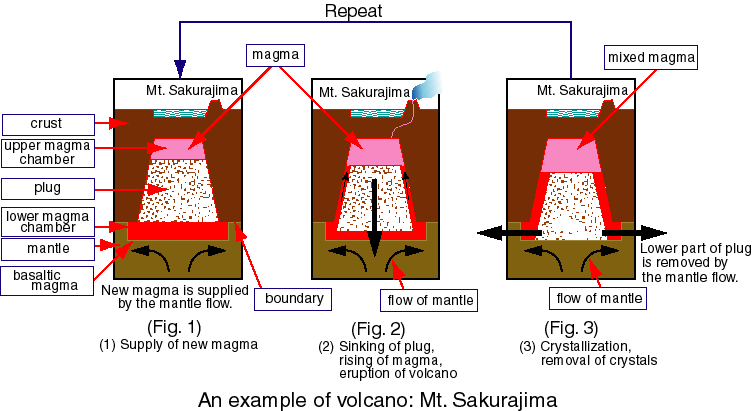 |
 Let's explain the mechanism of magma chamber Let's explain the mechanism of magma chamber
 by taking the case of Mt. Sakurajima for by taking the case of Mt. Sakurajima for  example. example.

 The underground structure The underground structure
 of a volcano consists of of a volcano consists of
 upper magma chamber, upper magma chamber,
 lower magma chamber lower magma chamber
 and cumulate plug in between. and cumulate plug in between.
 The upper magma chamber The upper magma chamber
 is located in the crust is located in the crust
 and the lower one around the boundary and the lower one around the boundary
 of the crust and the mantle. of the crust and the mantle.

 In the upper magma chamber, In the upper magma chamber,
 crystallization crystallization
 of magma advances of magma advances
 and the heavy crystals are and the heavy crystals are
 deposited (cumulated) deposited (cumulated)
 on the floor. on the floor.
 The deposits constitute the plug. The deposits constitute the plug.
 The remaining is light The remaining is light
 dacite magma. dacite magma.

 When the basaltic magma When the basaltic magma
 is newly supplied into is newly supplied into
 the lower chamber the lower chamber
 by the rising of by the rising of
 the mantle from the depths the mantle from the depths
 (Fig. 1), (Fig. 1),
 the cumulate plug starts the cumulate plug starts
 to sink down because it to sink down because it
 is heavy (Fig. 2). is heavy (Fig. 2).
 Hence, the primary Hence, the primary
 basaltic magma basaltic magma
 in the lower chamber in the lower chamber
 moves up through openings moves up through openings
 (cracks) to the upper chamber, (cracks) to the upper chamber,
 and mixes with the dacite magma and mixes with the dacite magma
 remained in the upper chamber to make remained in the upper chamber to make
 a mixture, andecite magma. a mixture, andecite magma.
 This migration of magma This migration of magma
 from the lower to upper chambers from the lower to upper chambers
 continues continues
 until the plug touches until the plug touches
 the bottom of the lower chamber. the bottom of the lower chamber.
 During this period, During this period,
 there occur several times of there occur several times of
 large-scale volcanic eruptions, in which large-scale volcanic eruptions, in which
 the extruded lava is accordingly the extruded lava is accordingly
 dacite or andecite. dacite or andecite.

 After the plug touches After the plug touches
 the floor of the lower magma chamber, the floor of the lower magma chamber,
 a part of the plug is a part of the plug is
 eroded and removed away eroded and removed away
 by the mantle flow (Fig. 3). by the mantle flow (Fig. 3).
 On the other hand, On the other hand,
 crystallization proceeds crystallization proceeds
 in the upper chamber, and in the upper chamber, and
 heavy crystalline matter heavy crystalline matter
 is deposited on the plug. is deposited on the plug.
 And then new magma is And then new magma is
 supplied into the lower magma chamber. supplied into the lower magma chamber.
 Thus the above-mentioned process is Thus the above-mentioned process is
 repeated. repeated.
 In the case of Mt. Sakurajima, In the case of Mt. Sakurajima,
 it seems probable that this process it seems probable that this process
 would be repeated every 600 years. would be repeated every 600 years.

|

 Top of Part 5
Top of Part 5

 Previous p.
Previous p.

 Next page
Next page
 It is quite rare
It is quite rare
 that the magma generated
that the magma generated
 in the mantle directly
in the mantle directly
 comes out on
comes out on
 the surface of the earth.
the surface of the earth.
 Generally, it would
Generally, it would
 appear on the surface
appear on the surface
 through volcanic eruption,
through volcanic eruption,
 after the modification of its own
after the modification of its own
 property (composition)
property (composition)
 in the magma chamber.
in the magma chamber.

